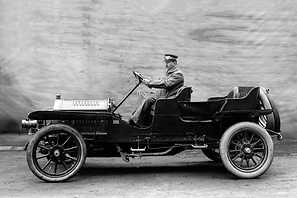In July 1907, Prince Heinrich of Prussia, the motoring-enthusiastic brother of the German Emperor Wilhelm II, donated a 13.5-kilogram model of a touring car made of pure silver as a challenge trophy for a major international touring race, which was to replace the Herkomer competitions and be held from 1908. This marked the start of the Prinz-Heinrich-Fahrten, whose declared aim was to perfect the touring car and promote automotive tourism. However, there were also stages that had a clear racing character. The regulations restricted participation to four-seater, four- or six-cylinder cars that were permitted to drive on public roads and had to have at least 2000 kilometres on the odometer on the day of scrutineering.
The first Prinz-Heinrich-Fahrt was organised from 9 to 17 June 1908 and covered a distance of 2201 kilometres. It ran from Berlin via Szczecin, Kiel, Hamburg, Hanover, Cologne and Trier to Frankfurt. There were 129 participants at the start.
Benz had prepared a total of nine cars – five with a nominal output of 50 hp/37 kW (displacement 6648 cc and 7479 cc) and two each with 75 hp/55 kW (displacement 9161 cc) and 25 hp/18 kW (displacement 3178 cc). As the regulations stipulated the bore dimensions of the individual displacement classes, all the four-cylinder engines used were emphatically undersquare with actual outputs ranging from 38 hp/28 kW to 98 hp/72 kW. Richard Benz and Bürger von Lengerke competed in the two 3.2-litre cars with 25 hp and cardan drive.
The winner was Fritz Erle in one of the special touring cars with a nominal output of 50 hp and a capacity of 7.5 litres, while second place in the overall standings went to Willy Pöge in a Mercedes. Ludwig Zimmern's 3.2-litre car, driven by Bürger von Lengerke, finished in fourth place overall and Edgar Ladenburg took sixth place in one of the two 75 hp 9.2-litre cars.


